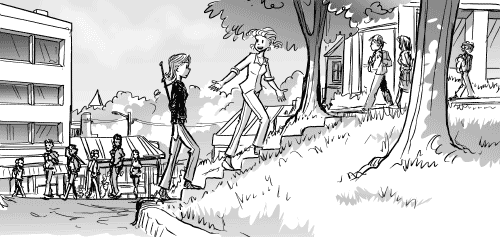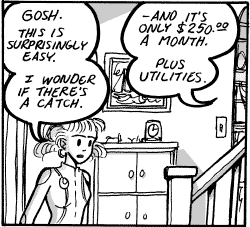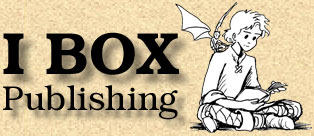|

Okay. After weeks of thinking and researching, here we are close to the finish line on this series.
--The finish line being the barrier between the creator and that glorious land where comics are both created and read without one being harassed, confused, pestered and bled by various corporate vampires.
Which at first seems like it ought to be easy enough. There are plenty of people out there who like reading books who have invested in some pretty handy e-book devices to help that fun process along. Millions of them in fact, most of whom are willing to spend the price of a couple cups of coffee for a decent bit of reading. A fair enough exchange between creator and reader should be a straight forward transaction made in good will. Author writes a book, converts it to a digital file and sells a copy to the happy reader.
The problem is, as we have learned, the whole process is made complex due to the fact that millions, if not billions of dollars are also involved in the affair, and various Goliaths, Behemoths and Kraken fish are skulking in and around the watering hole with their corded muscles and huge maws salivating copious quantities of publisher digesting bile. It's like feeing crocodiles; hold out a fair portion and you'll likely lose your arm.
We have looked at some of the details and arguments behind these corporate entities and the various deals they offer, and we have seen that it is possible, very likely even, that the author selling a digital Graphic Novel can barely scrape by, or in some cases, (Amazon) actually end up owing money after any given sale. Such is the way of life. Big predators predate, and the small critters who simply want to make and read books, simply have to live with it, fair or not. And just in case I've not made my position clear throughout this series, I think it all falls squarely into the 'unfair' category for reasons I've detailed earlier.

But while these huge and hungry gate-keepers are imposing their tolls and holding the roads hostage and generally making things difficult for publishers large and small, I have come upon a most interesting discovery.
They are not the only game in town.
There is, as I have found, a rather obvious solution. So obvious, in fact, I'd managed to miss it until a good way through my investigation into Kindles and iPads and the wide host of other digital readers. This comes even more surprising to me as the solution happens to be the same one I've used successfully before. It even has a name:
Self Publishing.
Back when the world was all about paper publishing, any creator wishing to get his or her works into the public was similarly fraught with difficulties involving large and domineering corporate entities. Though the hats and faces and mechanical details have changed dramatically, almost beyond recognition, it can be safely observed that there were gate keepers then just as there are now. Also then as now, if you wanted to step around those big players, the solution available is very simply this: Don't play their game.
Why this took me nearly two months of research to realize is beyond me. Caught up in details, I suppose. But there it is. D.I.Y. "Do It Yourself."
Don't want to pay Amazon's exorbitant storage and bandwidth fees? Well then don't. Host the file yourself and send it across the internet directly to your customer without involving any middle men.
Don't want to buy an Apple computer in order to use their development and iTunes account management software? Then don't. Write the code yourself on whatever machine you already own.
Don't want to give 30% plus various service and registration fees, foreign taxes and more percentage cuts to aggregator services while receiving little actual service (other than having your listing buried beneath thousands of other entries?) Sheesh. Don't! Sell direct.
"Okay, Mark," I can hear you ask. "That's all fine and well, but how do you propose we achieve this? How?"
Ah ha! I'm glad you asked. Because you see, I've had my nose deep in reading and trial and error research exactly so I could answer that very question.
Let's begin. . .
Making The Book
Actually I'm not going to bother with much here. Information about how to format and create your own files suitable for presentation on tablets and e-book readers is easily available elsewhere on the web. Many authors have explained the hows and wherefores on this subject at length, so it would be a waste of my energies to add to the cacophony. I may attempt to write something on the more specific job of converting a graphic novel to digital reader formats at some point, but for now I will only say in brief:
I like the .epub format. It's a nearly universal ebook format, it works well and is easily converted into all the other formats you will need, including Kindle files, (.mobi). I have found a number of free programs which help out in this process, one of my favorites being Calibre; an excellent tool for converting one file to another, and it's also a fairly slick reader, while it's at it. There are other good pieces of software out there, but would-be self publishing eBook authors and cartoonists will find those soon enough as they seek to format their work. That's nuts and bolts stuff and all it takes is a bit of time and sweat to figure it out. Nobody needs me for that.
Selling and Distributing The Book
Now HERE is where things get juicy!
One of the main advantages offered by Apple and others is that they handle all of the fiddley, under-the-hood stuff. They manage storage and delivery. They have all the systems worked out so that a customer can click the 'Buy' button and smoothly, automatically, have money moved between accounts and have books reliably delivered to the customer's device. That's not so simple for the small press publisher.
You can't just put up a PayPal link on your website and then upon making a sale, personally email a copy of your book to each buyer. Well, of course you can, but not without difficulties. Large files pose challenges; while a regular eBook is often around the same size in kilobytes as a medium-sized digital photograph, a full Graphic Novel tends to measure in the tens of megabytes. Sending files of that size is a fairly proven way to choke even the most forgiving of email systems. As well, on the publisher end of things, having to personally oversee each single sale means delivery might take up to a day or more given that the publisher will probably have do things in life which do not include sitting anxiously in front of a screen all day and night. Further, if a large volume of orders comes through at once, the publisher when s/he IS seated at the computer will be faced with doing rather lot of cutting and pasting and waiting around for big files to upload to their destinations (while hopefully not be rejected by email servers). A cumbersome practice not entirely in keeping with the utopian promise of instantaneous information flow we've come to expect from today's internet.
The other option is that you store your ebook file somewhere out there on the web and keep a secret URL address which you only give to people who have paid you six bucks or whatever you're charging for the graphic novel you've written and drawn. The reader forwards money and you forward them an email containing the download address. Since you only need to upload the file once, you will cut a lot of idle minutes and hours of endless repeated uploads from your day. It will also solve the "Choke the Email System" problem. However, on the down side, it also means that anybody who happens to come across the URL where the eBook is stored would be be able to download your creation without permission.
I'm all for the sharing of physical books, in part because it's fun and healthy, and in part because they cannot be infinitely replicated. Books limit themselves nicely in this way. As well, I'm all for not having DRM (Digital Rights Management) software tricks hamper the customer's ability to read and store a piece of software/media any way they please so long as it doesn't leave their immediate collection and propagate out into the wild. When I'm dead and gone, I'd love for my work to be instantly available to everybody, everywhere, anytime, but in the duration between now and my eventual demise, I also wouldn't mind paying my rent and utility bills by making legitimate sales.
So what do you do?
The answer exists on what is called the, "Server Side".

That is, the giant warehouses filled with rows and rows of sturdy computers such as the one from which were sent the very words and images you are looking at right now, (I certainly don't have you plugged into my humble laptop); the industrial-strength computer where iboxpublishing.com is hosted is capable not just of serving up webpages for people to read, but it is also capable, and supremely so, of doing that which computers do best. Running very clever software.
In this case, what I'd need is for that big computer in that big warehouse to generate upon demand a unique, one-per-customer web address where said customer can download my eBook. One which will work for only that customer and nobody else, and then expire. Ten different customers would get ten different download addresses, and I don't have to fiddle around with the cut & paste function.
And how handy would that be?
Very. And of course, this is all entirely possible. Big computer servers in big computer server warehouses all across the globe do this kind of thing millions of times a day. But this also rather drops the would-be self-publisher into the deep end, because while it is entirely possible it's also a major pain to learn how to make it work for you. Which is where I step in...
As fortune would have it, there are a variety of software packages available which you can load onto that big web server computer and which will perform all of the handy tricks you'll need in order to sell and deliver eBooks in an automatic, smooth and reliable manner. Some of those software packages cost a lot of money to run, while others are (ta DA!) free and open source.

Turns out, my webhost which is situated down somewhere in the Southern U.S., has pre-installed on their servers a lot of software which they felt customers like me might find useful. One such pre-installed software package happens to do exactly what I need; it is called, OSCommerce. It handles the sales and delivery of digital goods, and as per its name, it is open source and free for use, with extensive user forums and help documents.
Ahhh. How very convenient!
So if you are one of those who, like me, is in the self-publishing game and are keeping notes while reading through this series, I shall do you the favor of summing up the main things you'll need in order to make all of this cleverness work:
1. First and foremost, you need a website, and you need it to be stored and served up from one of those big computers in a big warehouse somewhere. The term for this service is Webhosting. Some publishers and many bloggers manage to get by using a free webhost or a Facebook page. I don't, because I consider those unreliable and slow and you can't do a lot of the things I'm describing here. For the last fifteen years, I've been spending around $150 per year to keep the iboxpublishing.com website hosted on a big, professional server. I consider it a worthwhile expense very useful in many ways and you'll need to do the same thing if you want to proceed to the next step.
2. Software. You need your webhost to either allow you to install, (or which already has installed) some kind of digital sales/shopfront software. There are several packages available which can serve up a digital store-front able to accept payment and provide unique download addresses for digital content purchases.
3. Learn it. You need to read the user manuals provided by the webhost or by the software package itself and follow its directions so that you can set up your website store front and link it to a PayPal or some other credit card account.
These steps take some time and research, but in the end it's nowhere nearly as difficult as it all might sound. Working out what those steps were in the first place was the most difficult part, but I've just taken care of that.
Once done, you will find yourself in a rather unique position. . .
If you sell a digital book on-line using the above system, you will get to keep around 97% of the sale. The other 3% or less goes to the transaction company, PayPal or Bitcoin or WorldPay or whoever is providing the cash-moving services. 3% or less strikes me as being a far better deal than 30%.

You will not have to pay any user fees or jump through any of the other expensive, daunting hoops and traps laid out by third and fourth party 'distribution' outfits. No hair brained aggregation schemes, no toxic gambits, (like the one where if the percentage owed to you from all your sales doesn't top $150 with Apple, then Apple simply doesn't cut you a check at all, retaining 100% of the money paid by readers for your work. And if you do happen to earn more than some arbitrary cutoff, you will no longer need to pay Amazon's $10 to $15 service fee for having to put up with your audacious request for your money be transferred over to you. Infuriating little head aches of that nature simply go away.
And speaking of payment, it should also be mentioned that when you run your own sales site, all of that stuff happens immediately; no waiting till month's end. You don't have to sell a minimum number of copies, (other than one), or write fancy letters to the IRS to ask permission to not have them seize another 30% of your income despite not being an American, (if that applies to you), or pay up-front service fees, or worry that Amazon will arbitrarily discount your cover price without asking. None of that. It's just the creator and the reader sharing in an honest, parasite-free trade. I find that readers, by and large, tend to be sane and reasonable people who I usually get on with quite cordially. Cutting the sociopathic cult-of-greed corporate monsters out of the picture is. . , well, it makes for an altogether preferable experience.
Now, of course, going it alone always carries some extra costs and risks, so we ought to examine those now as well. . .

First of all, to run your own web based store front, as I have indicated, you'll need your own website. This requires some time and money. However, if you are already a self-publisher in any significant capacity, then you are more than likely already paying a web host and maintaining your own website. If you aren't, you'll need to start in order for any of this to work. --However, once you're there, extending your site to enable digital book sales doesn't cost any extra money and as in my case you may find that the service is already included in your web hosting package. The average web host charges between $10 and $25 per month for a base service, which is all a small publisher should likely require.
The second thing you need to consider when going it alone, and this is the big one everybody talks about. . , is that your book won't show up on iTunes / Amazon / Barnes & Noble, etc.
Is this a big deal? Well that depends. It depends on whether or not you believe those companies are able to do anything for you to begin with. Being buried beneath thousands of other titles is hardly a benefit. In the end, no matter where you are listed, you'll have to do your own marketing in order for any listing to make a difference, and this has always been the case. Frankly, I'm far from convinced that Amazon or Apple or Barnes & Noble or anybody else have much value when it comes to small-press book marketing. When there are twelve books front and center on the iTunes bookshelf, it's a pretty safe bet to say that your book isn't going to be among them. Ever. You'll be down in the basement somewhere with the other hopefuls.
Here's an odd thing, however. Many publishers cry the same refrain: "Amazon is fleecing us blind, but there's nothing we can do! We simply cannot afford to not be listed by them. So we put our books on Amazon (and gripe and complain and hang our heads in shame). You just have to. There's no choice."
Well I am sorry to any people who might think differently on this matter, and there are clearly many such people out there in force, but I find that attitude both baffling and more than a little cowardly.
If Amazon is destroying publishing, then why on earth do publishers continue to distribute through them? If all publishers collectively simply refused to sell through Amazon, the world would not suddenly stop wanting books. They'd just go elsewhere to buy them. The power Amazon wields is the power they have been given. And I just don't understand why people put up with it.
Well, actually I do.
It's part of the age old, "Everybody else is doing it, so clearly I must as well or I'll get left out!" syndrome. Herd psychology, plain and simple.
Bending before a bully's demands because they threaten to not let you into the popular circle otherwise is a threat which works on our most basic of animal instincts. Thus it is somewhat forgivable and very understandable, but no less appalling. Humans are not cows. --And with all due respect to the bovine population, (I actually adore cows; I think they're sweet), herd dynamics simply don't serve well for an advanced species. They lead to wars, broken economic systems, terrible fashion choices and companies like Amazon.
Further, Amazon threatening a publisher, especially a small press publisher, to be cut off from the popular exposure on their website is, as far as I can make out based on years of watching this stuff, about as completely a hollow threat as you're bound to find on the vast internet landscape. There are thousands upon thousands of items all over the web every day, from viral videos to email jokes, pictures, gossip, TV shows, software, news articles and blog entries of every stripe, all of which manage to rise to the top of public awareness quite without the benefit of Amazon's product listing service. There is no reason whatsoever that books could not do this as well.
The mistake is believing that Amazon does more than simply provide "Buy Now" buttons and handy user reviews. They don't. Heck, anybody with a PapPal account can put a "Buy Now" button on their website. And if you want to look for a book, Google, or any other search engine you care to name works just as lickety-split, if not more so.
So I just don't buy into the fear. I pulled the plug on my relationship with Amazon more than ten years ago and I'm still here, people are still reading my work and life is pretty good. And if a potential reader genuinely finds his or herself stumped beyond help upon finding my work unavailable on Amazon and cannot take the extra step to look a little more deeply, then I'm not altogether convinced that such a reader is really going to benefit from my work anyway. My work isn't popcorn and gumdrops, after all. Well, it sort of is, (who am I kidding?), but it's the kind you have to chew in order to find the good bits.
Okay. . , where were we. . ?
Right. Pros and Cons.
The final con is that of in-product ease of sales. That is, the Key to the Walled Garden.
For instance. . , on an iPad, if you come across an eBook and decide you want to purchase it, then gosh darn, you're in for an easy time as Apple will pleasantly usher you to a nice shiney button which looks like a glowing candy. Just tap it and maybe another one or two to confirm, and bang, the next thing you know, you're reading your eBook, or using your new App and feeling very special indeed. Very cool. Very convenient. Very deliberate.

But for the bedraggled grey warriors scratching out their existence beyond the mighty walls of the Sultan's temple, such magics are beyond our reach.
Heh. Well. . , actually, that's not quite as true as it once was.
Anybody with a web browser on their iPad, (which is every iPad owner), can find a website, hit a "Buy Now" button, download and open an ePub file, all with relatively little fuss. I realize in a previous installment that I had made a lot of grumpy noises about Apple's attention channeling tactics, and they do exist. Purchasing a book is not as simple as tapping a candy-coated button, and that lack of simplicity will certainly lead to a lower sales count. This is true. But it's not the end of the world. People with a Kindle which has no surfing capabilities will have to be counted upon to go that extra twelve feet across the living room to their laptop. I have faith in readers. Not just to be slightly more motivated than the average bear, but my kind of readers are going to be those, (well I hope anyhow, or I've been writing all the wrong stuff for the last eighteen years), who are generally more interesting, alive and motivated than a whole lot of average bears. I hope that doesn't sound arrogant. I find that I am quite happy to meet most of the people I run into, but my comics just aren't going to tickle every fancy and the fancies they tend to tickle most just seem to be, on a recurring basis, those of upbeat, energetic folks.
Those using Android devices are similarly capable. Walled Garden? Not anymore. The statuary, reflecting pools and trimmed hedges still look nice, but these days you can read whatever you want while sitting among their splendor.
Readers get their books, and I get my 97%, the salivating maws and coiled muscles grumble darkly from the shadows. And I continue having a roof over my head for the effort of pushing a drawing stylus around my drafting board while thinking up things to put in word balloons. A fair bargain, I'd say.
Which brings us to that moment of my ceasing with the big talk and actually walking the walk. Do I really want to jeopardize my career by giving Apple, Amazon and all the others the cold shoulder? Do I really want to strike out into the wilderness of Self Publishing and go it alone? Do I truly believe in my own line of reason. . ?
Well, now. Those who have known me or my work for any length of time will probably have already jumped to the conclusion at this point. I'm the fellow who smiles, "aw shucks" and feels genuinely complimented when rebuked, "You have a problem with authority!" --and then who finds himself all muddled when the accuser realizes that I've not taken the comment in the manner intended. This really does happen sometimes.
Self Publishing is either in your blood or it isn't. I think it might be genetic, (or perhaps some sort of incurable condition picked up during youth while playing in a dirty sandlot behind the school).
And fortunately for me. . , I appear to have a curious and quite significant advantage this time around.
While putting together the first Stardrop Graphic Novel in eBook form, I was able to confirm something interesting about the format. Stardrop happens in squares. Well, I knew that. That part didn't need confirming. --In fact, I'd planned it that way from the beginning simply to make sure the uniform frame shapes could fit in different paper sizes easily. But there are other advantages I'd not really considered.
See, when Stardrop runs in its primary venue, Wolfville's town paper the Grapevine, it presses across the bottom quarter of an 11" x 17" sheet of paper folded sideways. The strip runs 4 panels across and 3 high, forming up a nice 12 panel block of comics. However, for the graphic novels, the panels don't fit that way. The paper page in the digest-sized book is better suited to stacking them 3 high and 2 across making for 6 panels per page.
Well, it so happens that digital reading devices, like paper sheets, also come in lots of different shapes and sizes. Stardrop, due to its being made up of lots of little square frames, fits neatly in all of them, from the humble smart phone, reading 1 or 2 panels at a time, to the big laptop screen which can fit twenty or thirty panels in one go. And they all read nicely. How's that for convenient?
 

See, one of the nice things about computers and the ePub format is that the panels automatically re-flow to efficiently fill the available space. The Stardrop ePub file morphs to fit whatever device you happen to be reading it on, summoning up a custom built page for each individual reader to experience. It's really pretty cool to see it in action. Customized comics pages for the discerning reader. Very cool, indeed!
And moreover, I can honestly say that I've never seen any other graphic novel perform this tidy feat before. In fact, (and I've looked), Stardrop with its ability to reflow like this, has the unique capacity to read more easily and more comfortably than any other digitally presented graphic novel currently in existence. And I mean, planet-wide.
I know.
That's a helluva claim to make, but there you go.
And while we're on the subject of audacious observations, it also struck me one spine-tingling day that my company, I Box Publishing, has been in active existence for more years than that other trade marked line by you-know-who, builder of many popular digital devices similarly prefixed with a singular letter "i". That Stardrop comes packaged in little i-boxes for little i-devices is, well. . , timely.
But please don't alert Apple to that little nugget of information. Even though the I Box Publishing brand name pre-dates by a few years the iPod, iMac, iPhone and iPad, and all of Steve Jobs other rapidly mutating brain children, I don't happen to have 80 Billion dollars with which to generously hurl myself around the legal system. This means, should they choose to, Apple could and would destroy me and sprinkle my ashes with self-indulgent abandon wherever they wanted. The only reason they haven't done so is either that, A) they've never heard of me and my little publishing outfit, and/or B) doing so would cause more controversy, trouble and incredulous press releases than not doing so. As it stands, I'm all for keeping things exactly the way things are, thank-you very much. I like my tidy little Hobbit life filled with making comics, and I don't much care for adventures. Not that kind, anyway. Nasty things. Make you late for tea.

But still. . , I think it's very interesting how Stardrop is so uniquely suited to presentation on digital e-readers and that my company name just happens to fit ever so neatly into the i-device paradigm which has spread itself across our culture like a vast electric blanket. Occasionally, and rather more often than people seem to realize, life is like that.
And so. . , to finish this entry off in diligent Self Publisher form, I present to you, The Plug:

It is this: If you happen to have an eInk device, or a tablet or a smart phone, and you'd like to read the handy new digital Stardrop Graphic Novel on it. . , which of course, I would very much appreciate, you may do so using the link below.
$4.95 gets you a copy of the first and fine Stardrop Graphic Novel! That's three years and many hundreds of hours of focus, scripting and drawing all for the price of a couple cups of coffee. (Or one of the really fancy ones with sprinkles.)

Stardrop eGraphic Novel - Book 1
(for Kindle, iPad, Android and others)
Just $4.95!
Thank-you for reading!
(Self-publishers, please direct any questions to my email; I'll be happy to lend a hand if you are interested in following this same route.)
Cheers!
-Mark Oakley
August 27th, 2012
Wolfville, Nova Scotia
| 
